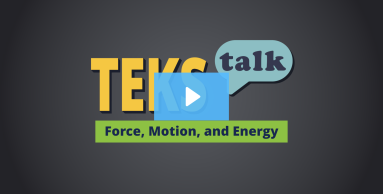- Science
- Grade 2
- Force, motion, and energy
Science.2.8.A
demonstrate and explain that sound is made by vibrating matter and that vibrations can be caused by a variety of means, including sound;

Knowledge and Skills Statement
The further explanation is designed to be a resource for educators that helps them better understand the topic their students are learning. Further explanations may be written at a more complex level than would be expected for students at the grade level.
Sounds caused by humans: Hitting a drum, walking across a floor, plucking a guitar string, pulling a bow across a violin, loud music playing in a car, talking
Sounds that occur naturally: Wind blowing through trees, earthquakes, thunder, a rock rolling down a hill, barking, waves hitting a beach
Tap a tuning fork on a desk. Ask students what they notice. Students will likely describe the sound that a tuning fork makes. Ask students if they notice anything with their eyes. If students are close enough, they should be able to see the prongs of the tuning fork vibrate as they hear the tone. Tell students that this is an example of sound being made by vibrating matter. Ask students to brainstorm other ways they might demonstrate that sound is made by vibrating matter. Examples that are appropriate for a grade 2 student include being able to feel the vibrations while touching a working speaker or feeling the vibrations in their throat when they talk.
Research
Sickel, Aaron J., Michele H. Lee, and Enrique M. Pareja. "Sound Science: An Approach to Teaching Content, Inquiry Skills, and the Nature of Science." Science and Children 48, no. 1 (2010): 59–63.
http:// www.nsta.org/science-and-children/science-and-children-september-2010/sound-science.
Summary: The teachers in this article use the 5E Model and focus on assisting students in developing an understanding of scientific inquiry. Students began by making sounds using everyday items and describing what they have in common. There were many misconceptions about how sound is produced. Students completed activities where they used all of their senses to observe how different sounds are made. Students concluded that sounds are produced by vibrations or force (plucking or hitting an object). The teachers played loud music for students to allow them to observe how the vibrations from the sound of the music could move the salt they had placed nearby. The activity ended with a class discussion so that students could explain and defend their explanations.
Research
Brown, Tom, and Kim Boehringer. “Breaking the Sound Barrier.” Science and Children 44, no. 5 (2007): 35–39.
http://www.jstor.org/stable/43172929.
Summary: The authors of this article explain how vibrations produce sound and affect pitch. Students start by brainstorming what they already know about sound. Many students may already know that sound waves exist but need to learn how they work. Students need to know that vibrations produce sound waves that travel through matter and the speed of the vibrations changes the pitch of the sound. In this article, students complete several centers exploring different items that produce or change sound. Students observe how vibrations change the pitch of sounds. Teachers should ask guiding questions during these activities while students record their observations.
